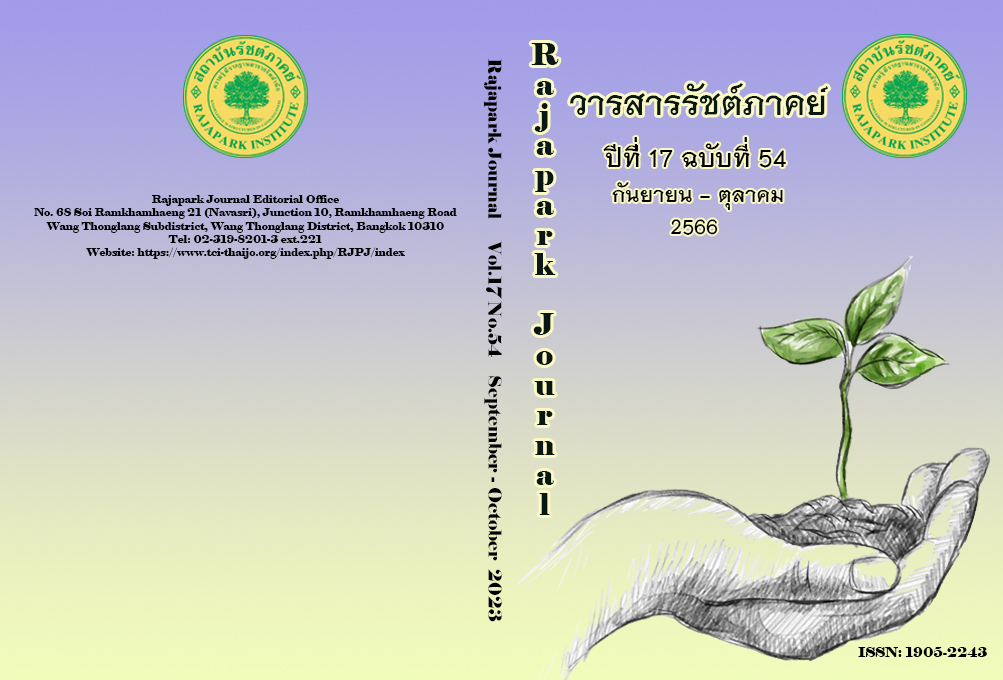The Economic Impact: A Case Study of Bang Pa-In-Nakhon Ratchasima Intercity Motorway Project
Main Article Content
Abstract
The research aims to 1) analyze the economic linkages of the Bang Pa-In-Nakhon Ratchasima Intercity Motorway Project and 2) evaluate the economic impacts of the Bang Pa-In-Nakhon Ratchasima Intercity Motorway Project. This research will be conducted quantitatively, analyzing the production factors and outputs that have been further improved in the construction sector of the Bang Pa-In-Nakhon Ratchasima Intercity Motorway Project. These will be incorporated into the production and output tables. The research findings indicate the following: 1) The backward multipliers of the intercity expressway project mentioned have higher values than the forward multipliers. This demonstrates that the Bang Pa-In-Nakhon Ratchasima Intercity Motorway Project has a greater impact on connecting with other industries in the upstream sector. 2) The Bang Pa-In-Nakhon Ratchasima Intercity Motorway Project has resulted in an overall increase of 0.319% in the country's gross domestic product (GDP) compared to the baseline case, which is equivalent to a value of 44,368.03 million baht. The top 10 industries that experienced the highest increase in production output include mining and quarrying, the production of metal-based furniture and fixtures, engine and turbine manufacturing, cutting tool manufacturing, general-purpose machinery and equipment manufacturing using steel, cement production, petroleum and natural gas extraction, land transport of goods, business services, electricity generation, concrete product manufacturing, and job creation.
Article Details

This work is licensed under a Creative Commons Attribution-NonCommercial-NoDerivatives 4.0 International License.
Views and opinions appearing in the Journal it is the responsibility of the author of the article, and does not constitute the view and responsibility of the editorial team.
References
Bing, Z., Nuo, W., & Yixuan, W. (2022). The role of different transportation modes in China's national economy: An input–output analysis. In World Conference on Transport Research Society (WCTRS), 32, 92-102.
Dwiatmoko, H., Hidayat, A.K., Supriyatno, D., Mudjanarko, S.W., & Ramli, M.I. (2020). The influence of railway development on the Indonesian National Economy: An Input-output approach. In IOP Conference Series: Earth and Environmental Science, Vol. 419, The 3rd International Conference on Civil and Environmental Engineering (ICCEE 2019) 29-30 August 2019, Bali, Indonesia. DOI 10.1088/1755-1315/419/1/012104
Department of Highways. (2021, May 9). Bang Pa-In-Nakhon Ratchasima Intercity Motorway Project. http://www.doh-motorway.com/motorway-project/northeastern-route/m6/
Elburz, Z., Nijkamp, P., & Pels, E. (2017). Public Infrastructure and Regional Growth: Evidence from Turkey. European Journal of Transport and Infrastructure Research, 17(4), 495-507.
Gramlich, E. M. (1999). Infrastructure Investment: A Review Essay. Journal of Economic Literature, 32, 1176-1196.
Jian, W., & Michael, B. C. (2010). IO Based Impact Analysis: A Method for Estimating the Economic Impacts by Different Transport Infrastructure Investments in Australia. Australasian Transport Research Forum (ATRF), 33rd, 2010, Canberra, ACT, Australia.
Leontief, W. (1936). Quantitative Input-Output Relations in the Economic System of the United States. The Review of Economics and Statistics, 18, 105-125.
Leontief, W. (1986). Input-Output Economics (2nd ed.). Oxford University Press.
Miller, R. E., & Blair, P. D. (2009). Input–Output Analysis: Foundation and Extensions (2nd ed.). Cambridge University Press.
Niemeier, D. A. (1997). Accessibility: An Evaluation Using Consumer Welfare. Transportation, 24, 377-396.
Office of National Economic and Social Development Council. (2020, December 17). Sustainable Development Goals: SDGs. https://www.businesseventsthailand.com/uploads/image_file/file/220222-file-Vbfp1cdlO.pdf
Pradhan, R.P., & Bagchi T. P. (2013). Effect of Transportation Infrastructure on Economic Growth in India: The VECM Approach. Research in Transportation Economics, 38(1), 139-148.
Raghuram, G., & Babu, R. (2001). Alternative Means of Financing Railways. In G. Raghuram, R. Jain, S. Sinha, P. Pangotra., & S. Morris (Eds.). Infrastructure Development and Financing: Towards a Public-Private Partnership. Macmillan.
Ramanathan, R., & Parikh, J. K. (1999). Transport Sector in India: An Analysis in the Context of Sustainable Development. Transport Policy, 6(1), 35-45.
Ramanathan, R. (2001). The Long-run Behavior of Transport Performance in India: A Cointegration Approach. Transport Research Part A, 35, 309-320.
Ridwan, A., Ofyar Z, T., & Sony S, W. (2015). Applying Input-output Model to Estimate the Broader Economic Benefits of Cipularang Tollroad Investment to Bandung District. In The 5th International Conference of Euro Asia Civil Engineering Forum (EACEF-5), 125, 489-497. DOI: 10.14456/jmcupeace.2016.58
Varnavskii, V. (2021). International Input-Output Tables as a Tool for Structured Analysis and Assessment of Stability in Russian Transport Sector. In The 20th IFAC Conference on Technology, Culture, and International Stability TECIS 2021, 54(13), 710-714.


